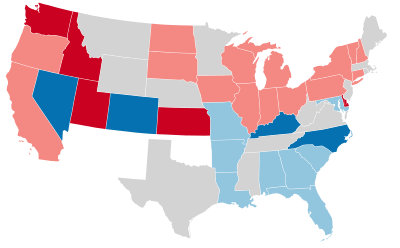| ← 1900 1901 1902 1903 1904 → Midterm elections | |
| Election day | November 4 |
|---|---|
| Incumbent president | Theodore Roosevelt (Republican) |
| Next Congress | 58th |
| Senate elections | |
| Overall control | Republican hold |
| Seats contested | 30 of 90 seats [1] |
| Net seat change | Democratic +4 [2] |
 | |
| Results of the elections: Democratic gain Democratic hold Republican gain Republican hold | |
| House elections | |
| Overall control | Republican hold |
| Seats contested | All 386 voting seats |
| Net seat change | Democratic +25 [2] |
| Gubernatorial elections | |
| Seats contested | 27 |
| Net seat change | 0 |
 | |
| 1902 gubernatorial elections results Democratic gain Democratic hold Republican gain Republican hold Silver hold | |
Elections were held for the 58th United States Congress, and occurred in the middle of Republican President Theodore Roosevelt's first term, during the Fourth Party System. Roosevelt had become president on September 14, 1901, upon the assassination of his predecessor, William McKinley. Republicans retained a majority in both chambers of Congress, while the Populist Party and Silver Republican Party disappeared from Congress.
Contents
Reapportionment added twenty nine seats to the House. Democrats picked up several seats in the newly enlarged House, while Republicans made lesser gains. Republicans continued to control the chamber with a slightly diminished majority. [3]
In the Senate, Republicans and Democrats each picked up one seat, while the Populist Party lost both its seats. Republicans maintained a commanding majority in the chamber. [4]